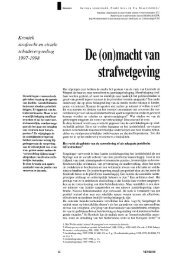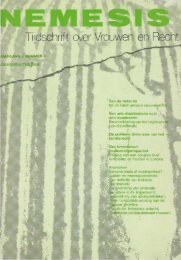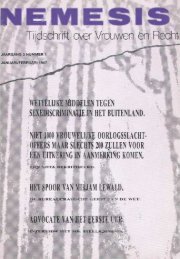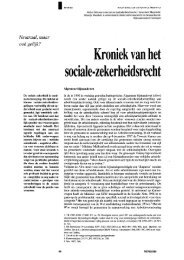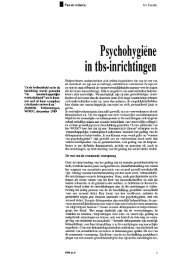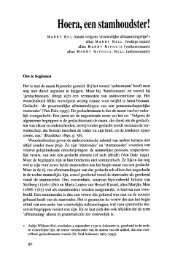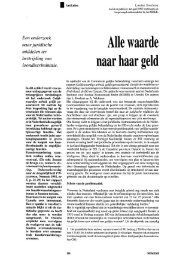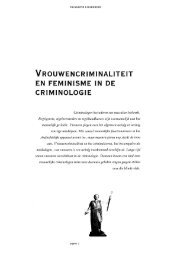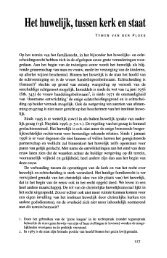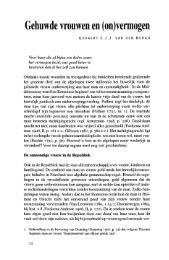(2001) nummer 1 januari/februari - Nemesis
(2001) nummer 1 januari/februari - Nemesis
(2001) nummer 1 januari/februari - Nemesis
You also want an ePaper? Increase the reach of your titles
YUMPU automatically turns print PDFs into web optimized ePapers that Google loves.
I TAKING<br />
born, he regularly visited the child. Unknown to the<br />
sperm donor, however, the mother and co-parent filed<br />
a co-parent adoption. They did not inform the adoption<br />
court of the identity of the sperm donor, but merely<br />
stated in the petition that the child was born by artificial<br />
insemination. Approximately one year after the<br />
adoption was granted, the women terminated the<br />
sperm donor's visitation. He filed a petition to set aside<br />
the adoption, alleging fraud, and sought an order to declare<br />
mm the child's legal parent. The court granted the<br />
sperm donor's requests and ordered custody and visitation<br />
investigations. During the pendency of the custody<br />
action between the sperm donor and biological<br />
mother, the mother and the child's co-parent separated<br />
and the co-parent filed for custody of the child as well.<br />
Shortly before trial, the three parties entered into an<br />
agreement whereby the two women would share legal<br />
custody of the child and the father would exercise visitation.<br />
The court affirmed this arrangement, with the<br />
practical result that the child resided with the mother,<br />
and the child visited with the co-parent and the sperm<br />
donor twice a month. 32<br />
Analysis of the Known Sperm Donor Cases<br />
It appears from a reading of the cases that U.S. courts<br />
will go to any length to grant known sperm donors legal<br />
parent status. In the majority of the cases the courts<br />
characterized the biological mothers as untrustworthy;<br />
their testimony was not believed, ignored or used<br />
against them to support the known sperm donors'<br />
parental rights. For example, if the mother gave in to<br />
the requests of the sperm donor to see the child, then<br />
she encouraged the contact and could not cut it off. If<br />
she immediately asserted no contact from the minute of<br />
birth, she was seen as preventing the man from establishing<br />
a parent-child relationship. If there was a<br />
statute that stated the sperm donor had no parental<br />
rights, the courts interpreted the statute as applying<br />
only to cases in which a doctor did the insemination. If<br />
a doctor did the insemination, then the courts said the<br />
statute only applied to anonymous donors. If the statutory<br />
language was plain that all sperm donors, anonymous<br />
or otherwise, had no parental rights to the child,<br />
then the statute was found unconstitutional if the man<br />
asserted that the parties had an agreement otherwise. If<br />
32. One other case deserves mention, Myers v. Moschella, 611<br />
N.E.2d 1243, Ohio App. 1996, which involved an action to establish<br />
child support. In this case, the court noted that the obligation for<br />
child support arose out of a sperm donor asserting parentage rights,<br />
and being granted those rights, even though he had signed an agreement<br />
that the mother and her female domestic partner would assume<br />
full parental responsibility for the child.<br />
33. See Myers v. Moscella, id., Thomas S. v. Robin Y., 618 N.Y.S.2d<br />
356, App. Div. 1994, rev'g 599 N.Y.S.2d 377, Fam. Ct. 1993, Mclntyre<br />
v. Crouch, 780 P.2d 239, 83 ALR 4th 277, Or. App. 1989, rev.<br />
denied 784 P.2d 1110, Or. 1989, eert. denied495 U.S. 905, 1990.<br />
34. There have been no reported cases of a known sperm donor asserting<br />
parental rights to an AID child born to a married woman because<br />
almost all married couples use sperm, provided by a doctor,<br />
which is obtained from anonymous donors. However, there have<br />
been cases in which either the mother or her husband have requested<br />
a court declaration that an AID child born during the marriage was<br />
not a child of the marriage. See Michael J. Yarworsky, 'Rights and<br />
Obligations Resulting from Human Artificial Insemination', 83<br />
A.L.R.4th 295, 1991. In all but three cases, this request was denied.<br />
Two of these cases were decided prior to the enactment of an AID<br />
THE SIDE EXIT IN THE UNITED STATES NANCY G. MAXWELL<br />
the parties had a clear agreement the sperm donor<br />
would not be the legal parent, the court then refused to<br />
enforce the agreement, relying instead on the paternity<br />
statute's language, which stated that if the blood test<br />
showed a man was the father, the court must issue an<br />
order of parentage.<br />
One might understand a court's hesitation to use a<br />
statute to cut off a sperm donor' s ability to assert<br />
parental rights if the legislative intent was unclear and<br />
the application of the statute would prevent the sperm<br />
donor from presenting evidence about the intentions of<br />
the parties at the time of the insemination. However,<br />
the courts appear to be willing to look at the agreement<br />
of the parties only if the agreement might support the<br />
sperm donor's petition for legal parenthood. In at least<br />
two cases in which the child lived in a two parent<br />
household, being raised by two women, the court refused<br />
to enforce the agreement when it was clear that<br />
the agreement would cut off the parental rights of the<br />
sperm donor. 33 Thus, the cases support the courts' bias<br />
to preserve the biological model of a male and a female<br />
parent for the child, regardless of the presence of a nonbiological<br />
co-parent of the child and regardless of the<br />
lack of a true parent-child relationship with the sperm<br />
donor. Consequently, unlike the situation involving a<br />
heterosexual married couple, the U.S. courts are unwilling<br />
to break through the biological contribution of<br />
the sperm donor and unable to acknowledge that there<br />
is another person acting as the child's parent. Paradoxically,<br />
if the sperm donor were to assert legal parenthood<br />
of his biological child born in a heterosexual marriage,<br />
he would have little or no hope of doing so,<br />
because the courts would prevent his attempts by relying<br />
on the same AID statutes that the courts refused to<br />
apply in the situation of two female co-parents. 34 Consequently,<br />
in the United States biological parenthood<br />
means nothing if the child is born to a married heterosexual<br />
couple, but biological parenthood means everything<br />
if the child is born to a same-gender couple. 35<br />
Ignoring the Other Mother<br />
One of the most disturbing results of the U.S. cases is<br />
that granting the sperm donor's request for parental<br />
status may prevent the co-parent from ever having a<br />
statute that addressed the issue of whether an AID's child was a child<br />
bom of the marriage, (Doornbos v. Doornbos, Unreported, Super.<br />
Ct. Cook County, No. 54 S. 14981, app. dismd. 139 N.E.2d 844 (111.<br />
App. 1954) as discussed in Gursky v. Gersky, 242 N.Y.S.2d 40,6<br />
1963. The third case, in California, involved a doctor who secretly<br />
used his own sperm to inseminate a female patiënt, whose husband<br />
did not even know she was undergoing this procedure. Shin v. Kong,<br />
95 Cal. Rptr. 2d 304, lst Dist. 2000.<br />
35. In the near future, it is predicted that an ART procedure will<br />
make it possible for two women to be the biological parents of a child<br />
without any genetic contribution from a male. Under this particular<br />
ART procedure, the man's genetic material is removed from the<br />
sperm sheath and replaced with the genetic material found in one of<br />
the woman's egg. This sperm carrying the first woman's genetic material<br />
is then used to fertilize the second woman's egg. Conceivably<br />
either woman could gestate this egg to term. The child born of this<br />
procedure would be the biological child of the two women with no<br />
genetic contribution from a male. See Kyle C. Velte, 'Egging on Lesbian<br />
Maternity: The Legal Implications of Tri-gametic In Vitro Fertilization',<br />
7 Am. U. J. Gender Soc. Pol'y & L. 431, 1999.<br />
20 NEMESIS <strong>2001</strong> nr. 1



